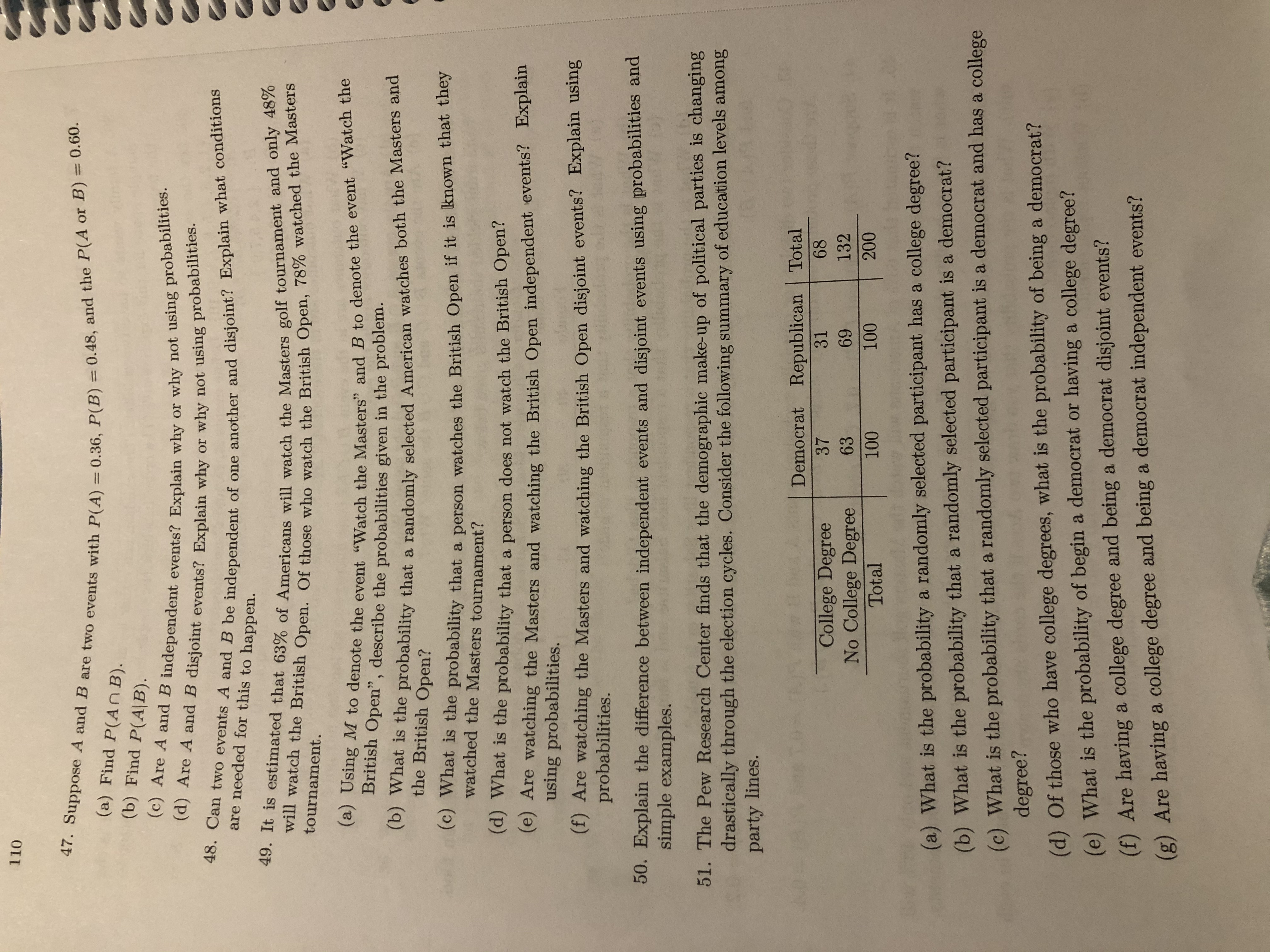
MATLAB: An Introduction with Applications
6th Edition
ISBN: 9781119256830
Author: Amos Gilat
Publisher: John Wiley & Sons Inc
expand_more
expand_more
format_list_bulleted
Concept explainers
Topic Video
Question
Number 49 parts A and B

Transcribed Image Text:110
47. Suppose A and B are two events with P(A) = 0.36, P(B) = 0.48, and the P(A or B) = 0.60.
%3D
%3D
(a) Find P(An B).
(b) Find P(A|B).
(c) Are A and B independent events? Explain why or why not using probabilities.
(d) Are A and B disjoint events? Explain why or why not using probabilities.
48. Can two events A and B be independent of one another and disjoint? Explain what conditions
are needed for this to happen.
49. It is estimated that 63% of Americans will watch the Masters golf tournament and only 48%
will watch the British Open. Of those who watch the British Open, 78% watched the Masters
(a) Using M to denote the event "Watch the Masters" and B to denote the event "Watch the
British Open", describe the probabilities given in the problem.
(b) What is the probability that a randomly selected American watches both the Masters and
the British Open?
(c) What is the probability that a person watches the British Open if it is known that they
watched the Masters tournament?
(d) What is the probability that a person does not watch the British Open?
(e) Are watching the Masters and watching the British Open independent events? Explain
using probabilities.
(f) Are watching the Masters and watching the British Open disjoint events? Explain using
probabilities.
50. Explain the difference between independent events and disjoint events using probabilities and
simple examples.
51. The Pew Research Center finds that the demographic make-up of political parties is changing
drastically through the election cycles. Consider the following summary of education levels among
party lines.
Democrat Republican Total
68
31
College Degree
No College Degree
Total
37
132
69
63
200
100
100
(a) What is the probability a randomly selected participant has a college degree?
(b) What is the probability that a randomly selected participant is a democrat?
(c) What is the probability that a randomly selected participant is a democrat and has a college
degree?
(d) Of those who have college degrees, what is the probability of being a democrat?
(e) What is the probability of begin a democrat or having a college degree?
(f) Are having a college degree and being a democrat disjoint events?
(g) Are having a college degree and being a democrat independent events?
Expert Solution
This question has been solved!
Explore an expertly crafted, step-by-step solution for a thorough understanding of key concepts.
This is a popular solution
Trending nowThis is a popular solution!
Step by stepSolved in 2 steps with 1 images

Knowledge Booster
Learn more about
Need a deep-dive on the concept behind this application? Look no further. Learn more about this topic, statistics and related others by exploring similar questions and additional content below.Similar questions
Recommended textbooks for you
 MATLAB: An Introduction with ApplicationsStatisticsISBN:9781119256830Author:Amos GilatPublisher:John Wiley & Sons Inc
MATLAB: An Introduction with ApplicationsStatisticsISBN:9781119256830Author:Amos GilatPublisher:John Wiley & Sons Inc Probability and Statistics for Engineering and th...StatisticsISBN:9781305251809Author:Jay L. DevorePublisher:Cengage Learning
Probability and Statistics for Engineering and th...StatisticsISBN:9781305251809Author:Jay L. DevorePublisher:Cengage Learning Statistics for The Behavioral Sciences (MindTap C...StatisticsISBN:9781305504912Author:Frederick J Gravetter, Larry B. WallnauPublisher:Cengage Learning
Statistics for The Behavioral Sciences (MindTap C...StatisticsISBN:9781305504912Author:Frederick J Gravetter, Larry B. WallnauPublisher:Cengage Learning Elementary Statistics: Picturing the World (7th E...StatisticsISBN:9780134683416Author:Ron Larson, Betsy FarberPublisher:PEARSON
Elementary Statistics: Picturing the World (7th E...StatisticsISBN:9780134683416Author:Ron Larson, Betsy FarberPublisher:PEARSON The Basic Practice of StatisticsStatisticsISBN:9781319042578Author:David S. Moore, William I. Notz, Michael A. FlignerPublisher:W. H. Freeman
The Basic Practice of StatisticsStatisticsISBN:9781319042578Author:David S. Moore, William I. Notz, Michael A. FlignerPublisher:W. H. Freeman Introduction to the Practice of StatisticsStatisticsISBN:9781319013387Author:David S. Moore, George P. McCabe, Bruce A. CraigPublisher:W. H. Freeman
Introduction to the Practice of StatisticsStatisticsISBN:9781319013387Author:David S. Moore, George P. McCabe, Bruce A. CraigPublisher:W. H. Freeman

MATLAB: An Introduction with Applications
Statistics
ISBN:9781119256830
Author:Amos Gilat
Publisher:John Wiley & Sons Inc

Probability and Statistics for Engineering and th...
Statistics
ISBN:9781305251809
Author:Jay L. Devore
Publisher:Cengage Learning

Statistics for The Behavioral Sciences (MindTap C...
Statistics
ISBN:9781305504912
Author:Frederick J Gravetter, Larry B. Wallnau
Publisher:Cengage Learning

Elementary Statistics: Picturing the World (7th E...
Statistics
ISBN:9780134683416
Author:Ron Larson, Betsy Farber
Publisher:PEARSON

The Basic Practice of Statistics
Statistics
ISBN:9781319042578
Author:David S. Moore, William I. Notz, Michael A. Fligner
Publisher:W. H. Freeman

Introduction to the Practice of Statistics
Statistics
ISBN:9781319013387
Author:David S. Moore, George P. McCabe, Bruce A. Craig
Publisher:W. H. Freeman